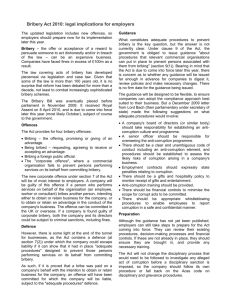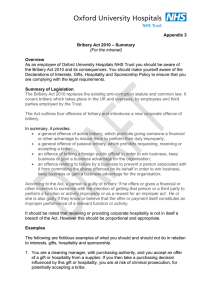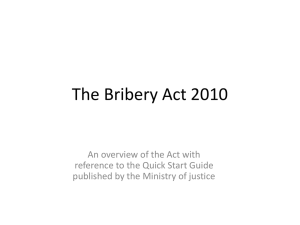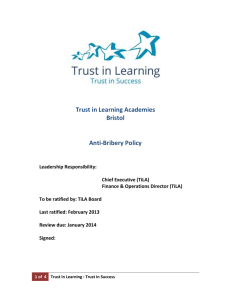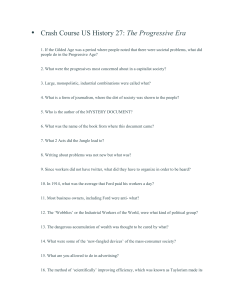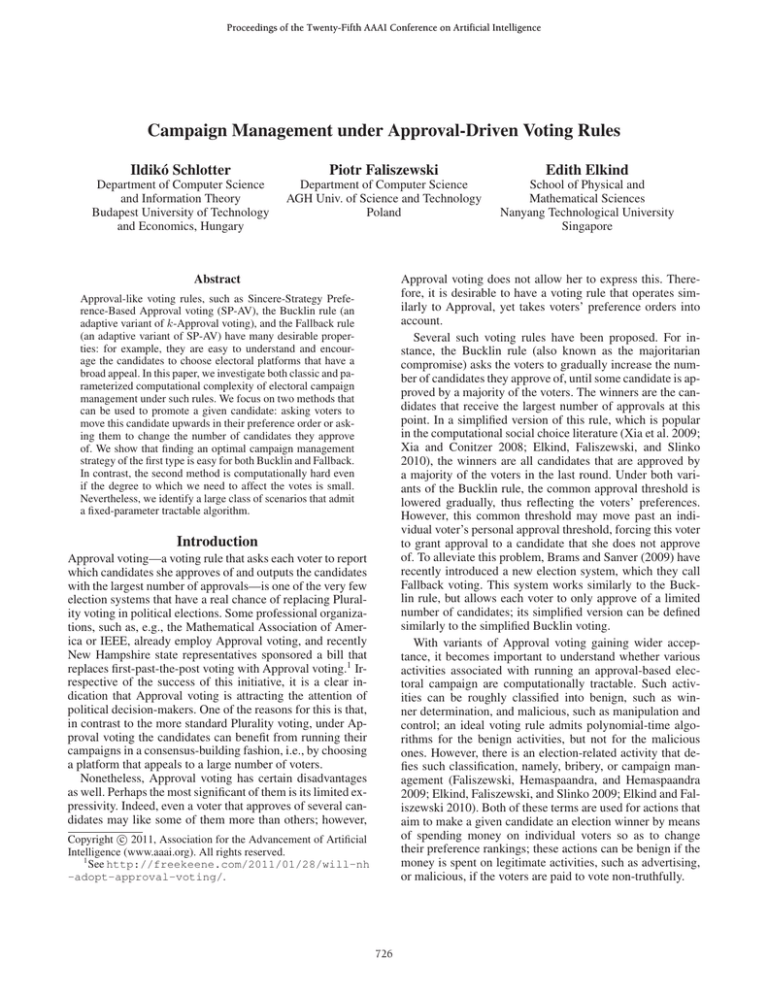
Proceedings of the Twenty-Fifth AAAI Conference on Artificial Intelligence
Campaign Management under Approval-Driven Voting Rules
Ildikó Schlotter
Piotr Faliszewski
Edith Elkind
Department of Computer Science
and Information Theory
Budapest University of Technology
and Economics, Hungary
Department of Computer Science
AGH Univ. of Science and Technology
Poland
School of Physical and
Mathematical Sciences
Nanyang Technological University
Singapore
Approval voting does not allow her to express this. Therefore, it is desirable to have a voting rule that operates similarly to Approval, yet takes voters’ preference orders into
account.
Several such voting rules have been proposed. For instance, the Bucklin rule (also known as the majoritarian
compromise) asks the voters to gradually increase the number of candidates they approve of, until some candidate is approved by a majority of the voters. The winners are the candidates that receive the largest number of approvals at this
point. In a simplified version of this rule, which is popular
in the computational social choice literature (Xia et al. 2009;
Xia and Conitzer 2008; Elkind, Faliszewski, and Slinko
2010), the winners are all candidates that are approved by
a majority of the voters in the last round. Under both variants of the Bucklin rule, the common approval threshold is
lowered gradually, thus reflecting the voters’ preferences.
However, this common threshold may move past an individual voter’s personal approval threshold, forcing this voter
to grant approval to a candidate that she does not approve
of. To alleviate this problem, Brams and Sanver (2009) have
recently introduced a new election system, which they call
Fallback voting. This system works similarly to the Bucklin rule, but allows each voter to only approve of a limited
number of candidates; its simplified version can be defined
similarly to the simplified Bucklin voting.
With variants of Approval voting gaining wider acceptance, it becomes important to understand whether various
activities associated with running an approval-based electoral campaign are computationally tractable. Such activities can be roughly classified into benign, such as winner determination, and malicious, such as manipulation and
control; an ideal voting rule admits polynomial-time algorithms for the benign activities, but not for the malicious
ones. However, there is an election-related activity that defies such classification, namely, bribery, or campaign management (Faliszewski, Hemaspaandra, and Hemaspaandra
2009; Elkind, Faliszewski, and Slinko 2009; Elkind and Faliszewski 2010). Both of these terms are used for actions that
aim to make a given candidate an election winner by means
of spending money on individual voters so as to change
their preference rankings; these actions can be benign if the
money is spent on legitimate activities, such as advertising,
or malicious, if the voters are paid to vote non-truthfully.
Abstract
Approval-like voting rules, such as Sincere-Strategy Preference-Based Approval voting (SP-AV), the Bucklin rule (an
adaptive variant of k-Approval voting), and the Fallback rule
(an adaptive variant of SP-AV) have many desirable properties: for example, they are easy to understand and encourage the candidates to choose electoral platforms that have a
broad appeal. In this paper, we investigate both classic and parameterized computational complexity of electoral campaign
management under such rules. We focus on two methods that
can be used to promote a given candidate: asking voters to
move this candidate upwards in their preference order or asking them to change the number of candidates they approve
of. We show that finding an optimal campaign management
strategy of the first type is easy for both Bucklin and Fallback.
In contrast, the second method is computationally hard even
if the degree to which we need to affect the votes is small.
Nevertheless, we identify a large class of scenarios that admit
a fixed-parameter tractable algorithm.
Introduction
Approval voting—a voting rule that asks each voter to report
which candidates she approves of and outputs the candidates
with the largest number of approvals—is one of the very few
election systems that have a real chance of replacing Plurality voting in political elections. Some professional organizations, such as, e.g., the Mathematical Association of America or IEEE, already employ Approval voting, and recently
New Hampshire state representatives sponsored a bill that
replaces first-past-the-post voting with Approval voting.1 Irrespective of the success of this initiative, it is a clear indication that Approval voting is attracting the attention of
political decision-makers. One of the reasons for this is that,
in contrast to the more standard Plurality voting, under Approval voting the candidates can benefit from running their
campaigns in a consensus-building fashion, i.e., by choosing
a platform that appeals to a large number of voters.
Nonetheless, Approval voting has certain disadvantages
as well. Perhaps the most significant of them is its limited expressivity. Indeed, even a voter that approves of several candidates may like some of them more than others; however,
c 2011, Association for the Advancement of Artificial
Copyright Intelligence (www.aaai.org). All rights reserved.
1
See http://freekeene.com/2011/01/28/will-nh
-adopt-approval-voting/.
726
Now, winner determination for all approval-based rules
listed above is clearly easy, and the complexity of manipulation and especially control under such rules is well understood (Baumeister et al. 2010; Erdélyi and Rothe 2010;
Erdélyi and Fellows 2010; Erdélyi, Piras, and Rothe 2011).
Thus, in this paper we focus on algorithmic aspects of
electoral campaign management. Following (Elkind, Faliszewski, and Slinko 2009; Elkind and Faliszewski 2010)
(see also (Dorn and Schlotter 2010)) who study this problem for a variety of preference-based voting rules, we model
the campaign management setting using the framework of
shift bribery. Under this framework, each voter v is associated with a cost function π, which indicates, for each k > 0,
how much it would cost to convince v to promote the target
candidate p by k positions in his vote. The briber (campaign
manager) wants to make p a winner by spending as little as
possible. This framework can be used to model a wide variety of campaign management activities, ranging from oneon-one meetings to phon-a-thons to direct mailing, each of
which has a per-voter cost that may vary from one voter to
another.
Note, however, that in the context of approval-based voting rules, we can campaign in favor of a candidate p even
without changing the preference order of any voter. Specifically, if some voter v ranks p in position k and currently
approves of k − 1 candidates, we can try to convince v to
lower her approval threshold so that she approves of p as
well. Similarly, we can try to convince a voter to be more
stringent and withdraw her approval from her least preferred
approved candidate; this may be useful if that candidate is
p’s direct competitor. Arguably, a voter may be more willing to change her approval threshold than to alter her ranking of the candidates. Therefore, such campaign management tactics may be within the campaign manager’s budget,
even when she cannot afford the more direct approach discussed in the previous paragraph. We will refer to this campaign management technique as “support bribery”; a variant
of this model has been considered by Elkind, Faliszewski,
and Slinko (2009).
In this paper, we investigate the algorithmic aspects of
both campaign management activities discussed above, i.e.,
shift bribery and support bribery. We consider five approvalbased voting rules, namely, SP-AV (as formalized by Brams
and Sanver (2006)), Bucklin (both classic and simplified),
and Fallback (both classic and simplified). We show that
shift bribery is easy with respect to both variants of the
Bucklin rule, as well as both variants of the Fallback rule.
The argument for the simplified version of both rules relies
on dynamic programming, while for the classic version of
these rules we use a more involved flow-based approach. In
contrast, support bribery tends to be hard; this holds even if
we parameterize this problem by the number of voters to be
bribed or the total change in the approval counts, and use
very simple bribery cost functions. Nevertheless, we identify a natural class of bribery cost functions for which support bribery is fixed-parameter tractable with respect to the
latter parameter.
The rest of this paper is organized as follows. In the next
section we formally define our model of elections, the voting
systems we study, and provide the necessary background on
(parameterized) computational complexity. We then present
our algorithms for shift bribery, followed by complexity results and a fixed-parameter tractable algorithm for support
bribery. We conclude the paper by presenting directions for
future research. We omit most proofs due to page limit.
Preliminaries
An election is a pair E = (C, V ), where C = {c1 , . . . , cm }
is the set of candidates and V = (v 1 , . . . , v n ) is the list of
voters. Each voter v i is associated with a preference order
i , which is a total order over C, and an approval count
i ∈ [0, |C|]; voter v i is said to approve of the top i candidates in her preference order. We denote by rank (c, v) the
position of candidate c in the preference order of voter v:
v’s most preferred candidate has rank 1 and her least preferred candidate has rank |C|. A voting rule is a mapping
that given an election E = (C, V ) outputs a set W ⊆ C of
election winners.
Voting rules Most voting rules commonly considered in
the literature do not make use of the approval counts. For instance, under k-Approval each candidate gets one point from
each voter that ranks her in top k positions. The k-Approval
score sk (c) of a candidate c ∈ C is the total number of
points that she gets, and the winners are the candidates with
the highest score. The Bucklin rule, which can be thought of
as an adaptive version of k-Approval, is defined as follows.
Given a candidate c ∈ C, let sB (c) denote the smallest value
of k such that at least n2 + 1 voters rank c in the top k positions, where n is the number of voters; we say that c wins
in round sB (c). The quantity kB = minc∈C sB (c) is called
the Bucklin winning round. Observe that no candidate wins
in any of the rounds < kB and at least one candidate wins
in round kB . The Bucklin winners are the candidates with
the highest kB -Approval score. Under the simplified Bucklin rule, the winners are the candidates whose kB -Approval
score is at least n2 + 1; all Bucklin winners are simplified
Bucklin winners, but the converse is not necessarily true.
We observe that k-Approval, despite its name, ignores the
approval counts entirely: a candidate c may fail to get a point
from a voter v i who approves of her (if i ≥ rank (c, v i ) >
k), or obtain a point from a voter v j who does not approve
of her (if j < rank (c, v j ) ≤ k). Similarly, neither version
of the Bucklin rule uses the information provided by the approval counts. In contrast, the SP-AV rule (Brams and Sanver 2006) relies heavily on the approval counts: each candidate gets one point from each voter that approves of her,
and the winners are the candidates with the highest number
of points. Finally, Fallback voting (Brams and Sanver 2009)
makes use of both the preference orders and the approval
counts. Specifically, under this rule we apply the Bucklin
rule to the election obtained by deleting each voter’s nonapproved candidates from her preference ranking. Since the
preference orders are truncated, it may happen that no candidate is ranked by more than half of the voters, in which case
the candidates approved by the largest number of voters are
elected. We can replace the Bucklin rule with the simplified
Bucklin rule in this construction; we will refer to the result-
727
ing rule as the simplified Fallback rule.
bribery for SP-AV, where the briber can both shift the preferred candidate and change the voters’ approval counts. In
this work, we find it more convenient to separate these two
types of bribery. Thus, we will now define support bribery,
which focuses on changing the number of approved candidates.
First, we need to introduce another family of cost functions, which provide information about the costs of increasing/decreasing the number of candidates approved by each
voter. Specifically, we assume that each voter v i also has a
support bribery cost function σ i : Z → Z+ ∪ {+∞}, which
satisfies (a) σ i (0) = 0 (b) for each k > 0, σ i (k) ≤ σ i (k +1)
and σ i (−k) ≤ σ i (−k − 1). For a given k ∈ Z, we interpret
σ i (k) as the cost of convincing v i to approve of i + k candidates. Clearly, it suffices to define σ i on [−i , |C| − i ],
where i is the approval count of v i . We are now ready to
define the support bribery problem.
Definition 2. Let R be a voting rule. An instance of RSUPPORT BRIBERY problem is a tuple I = (C, V, Σ, p),
where C = {p, c1 , . . . , cm−1 } is a set of candidates, V =
(v 1 , . . . , v n ) is a list of voters, where each voter v i is represented by her preference order i and her approval count
i , and Σ = (σ 1 , . . . , σ n ) is a family of support bribery cost
functions (each represented by listing its values for all appropriate arguments). The goal is to find a minimal value
b such that there is a vector t =(t1 , . . . , tn ) ∈ Zn with
n
the following properties: (a) b = i=1 σ i (ti ), and (b) if for
each i = 1, . . . , n voter v i changes her approval count from
i to i + ti , then p is an R-winner of the resulting election.
When discussing NP-completeness, we consider a decision version of this problem, where we ask if there exists a
bribery whose cost does not exceed a given value b.
There are two interesting special cases of support bribery
that can be derived from the general model by setting
the bribery costs so that decreasing/increasing the approval
counts is prohibitively expensive. Specifically, we will say
that a support bribery cost function σ is positive if σ(k) =
+∞ for any k < 0 and negative if σ(k) = +∞ for any
k > 0. The support bribery with positive cost functions
corresponds to the setting where the campaign manager can
only increase the voter’s approval counts, and can be viewed
as a fine-grained version of control by adding voters; similarly, the support bribery with negative cost functions can be
viewed as a refinement of control by deleting voters.
Note also that, just as in the case of control problems, we
can consider destructive support bribery, where the goal is
not to ensure that the preferred candidate p wins the election, but rather that some despised candidate d does not. In
the context of control, this problem was studied by Hemaspaandra, Hemaspaandra, and Rothe (2007).
Parameterized complexity The framework of parameterized complexity deals with computationally hard problems.
In a parameterized problem, each input instance I comes together with an integer k called the parameter, and the aim
is to design algorithms that are efficient if the value of the
parameter is small. Formally, a problem is said to be fixedparameter tractable (FPT) with respect to parameter k if it
admits an algorithm whose running time on an input (I, k)
is f (k)|I|O(1) for some computable function f ; note that the
exponent of |I| does not depend on k. Though f is typically
an exponential function, such an algorithm is usually more
efficient than one running in time O(|I|k ).
To capture problems that are not fixed-parameter
tractable, researchers typically use the W-hierarchy, of
which the first two levels are W[1] and W[2] (P ⊆ FPT
⊆ W[1] ⊆ W[2] ⊆ . . . ). Intuitively, W[1] is a parameterized analog of NP. W[1]-hardness and W[2]-hardness are
defined in a standard way, on the basis of parameterized reductions.
W[1]-hardness (or, worse yet, W[2]-hardness) yields
strong evidence that we cannot expect an FPT algorithm for
the problem with the given parameterization. For a more extensive treatment of parameterized complexity, we refer the
reader to e.g., (Downey and Fellows 1999).
Campaign Management
The following definition is
adapted from (Elkind and Faliszewski 2010), which itself is
based on the one in (Elkind, Faliszewski, and Slinko 2009).
Definition 1. Let R be a voting rule. An instance of RSHIFT BRIBERY problem is a tuple I = (C, V, Π, p), where
C = {p, c1 , . . . , cm−1 }, V = (v 1 , . . . , v n ) is a list of voters
together with their preference orders over C (and approval
counts, if R uses them), Π = (π 1 , . . . , π n ) is a family of
cost functions, where each π i is a non-decreasing function
from [0, |C|] to Z+ ∪ {+∞} that satisfies π i (0) = 0, and
p ∈ C is a designated candidate.2 The goal is to find a minimal value b for which there
a vector t = (t1 , . . . , tn ) ∈
is
n
i
(Z+ )n such that (a) b =
i=1 π (ti ), and (b) if for each
i = 1, . . . , n we shift p upwards in the i-th vote by ti positions, then p becomes an R-winner of E. We denote this
value of b by opt(I).
In words, π i (k) is the cost of shifting the preferred candidate p forward by k positions in the preferences of the ith voter. We will refer to the vector t = (t1 , . . . , tn ) as a
shift action, and denote by shf (C, V, t) the election obtained
from (C, V ) by shifting p forward
n by ti positions in each
vote. Also, we write Π(t) = i=1 π i (ti ). If rank (p, vi ) =
k, but a shift action prescribes shifting p by k > k positions
in vi ’s ranking, we simply place p on top of the vote.
Shift bribery does not change the voters’ approval counts.
A more general notion of bribery, which is relevant for
SP-AV and (simplified) Fallback voting, was proposed by
Elkind, Faliszewski, and Slinko (2009) in the technical report version of their paper. Specifically, they defined mixed
Shift Bribery
In this section, we present our results for SHIFT BRIBERY
under the Bucklin rule and the Fallback rule. We start by
describing our algorithm for the simplified version of the
Bucklin rule; this algorithm can be modified to work for the
simplified version of the Fallback rule.
Theorem 3. Simplified Bucklin-SHIFT BRIBERY is in P.
2
Each of our cost functions π i is specified by providing its values π i (0), π i (1), . . . , π i (|C|).
728
Proof. Given an instance I = (C, V, Π, p) of Simplified
Bucklin-SHIFT BRIBERY, let m = |C|, n = |V |, and let k
be the Bucklin winning round for (C, V ). Let W ⊆ C \ {p}
be the set of the simplified Bucklin winners in (C, V ).
Let t = (t1 , . . . , tn ) be a minimal optimal shift action for
I, i.e., Π(t) = opt(I), p is a winner in shf (C, V, t), but p
is not a winner in shf (C, V, s) for any s = t with si ≤ ti
for all i = 1, . . . , n (note that an optimal shift action is not
necessarily minimal, as it may include some shifts of cost 0
that are not needed to make p a winner).
Let be the Bucklin winning round in shf (C, V, t). We
have ∈ {k, k + 1}. Indeed, any shift action moves any
candidate in W by at most one position downwards. Therefore, in shf (C, V, t) all candidates in W win in round k + 1,
and hence ≤ k + 1. Now, suppose that < k. In (C, V )
the (k − 1)-Approval score of any candidate is at most
n2 , so the only candidate that can win in round < k in
shf (C, V, t) is p, and for that she has to be moved into position in at least some voters’ preferences. However, moving p into position k in those voters’ preferences suffices to
make p a winner in round k (and thus an election winner),
and we have assumed that t is minimal. This contradiction
shows that ≥ k. Hence, to find an optimal shift bribery,
it suffices to compute the cheapest shift action that makes
p a winner in round k, as well as the cheapest shift action
that makes p a winner in round k + 1 and ensures that no
other candidate wins in round k, and output the cheaper of
the two.
To win in round k, p needs to obtain n2 + 1 − sk (p)
additional k-Approval points. Thus, to find the cheapest shift
bribery that makes p win in round k, we consider all votes
in which p is not ranked in the top k positions, order them
by the cost of moving p into the k-th position (from lowest
to highest), and pick the first n2 + 1 − sk (p) of these votes.
Let s denote the shift action that moves p into position k in
each of those votes.
Computing a shift action that ensures p’s victory in the
(k + 1)-st round is somewhat more difficult. In this case we
need to ensure that (a) each candidate in W is demoted from
position k to position k +1 enough times not to win in round
k and (b) p’s (k + 1)-Approval score is at least n2 . Thus,
we need to find an optimal balance between bribing several
groups of voters.
For each c ∈ C \ {p}, let Vc denote the set of all voters
that rank c in the k-th position and rank p below c; note
that c = c implies Vc ∩ Vc = ∅. Let us fix a candidate c in
C \{p}. To ensure that c does not win in round k, we need to
shift p into position k in at least n(c) = max(0, sk (c)− n2 )
votes in Vc . Note that n(c) > 0 if and only if c ∈ W . Thus,
if for some c ∈ W we have |Vc | < n(c), there is no way to
ensure that no candidate in C wins in round k, so in this case
we output s and stop.
Otherwise, we proceed as follows. Let Ac be the set of
all voters in Vc that rank p in position k + 1, and let Bc =
Vc \ Ac . Note that for each vote in Ac , shifting p into the kth position does not change the (k + 1)-Approval score of p,
while doing the same for a vote in Bc increases the (k + 1)Approval score of p by one. For each i = 0, . . . , |Bc |, let
b(c, i) be the minimum cost of a shift action that (a) shifts p
into position k +1 or above in i votes from Bc , and (b) shifts
p into position k in at least n(c) votes from Ac ∪ Bc . We
can compute each b(c, i) in polynomial time using dynamic
programming. To do so, for each i and j, 0 ≤ i ≤ j ≤ |Bc |,
and each h = 0, . . . , n(c), we define b(c, i, j, h) to be the
cost of a minimum-cost shift action that only involves the
voters in Ac and the first j voters in Bc and that (a) shifts p
into position k +1 or above in i votes from Bc , and (b) shifts
p into position k in at least h votes from Ac ∪ Bc . If there is
no such shift action, we set b(c, i, j, h) = +∞.
Clearly, b(c, 0, j, h) can be computed by ordering the voters in Ac according to their cost of moving p into the k-th
position (from lowest to highest), and then bribing the first
h voters among them. We can similarly compute b(c, i, j, 0),
focusing on the first j voters in Bc and on shifting to position
k + 1. For all the remaining cases, we compute b(c, i, j, h)
using the following formula. Abusing notation, we write v j
to denote the j-th voter in Bc .
b(c, i − 1, j − 1, h) + C1 ,
b(c, i, j, h) = min b(c, i − 1, j − 1, h − 1) + C2 , (1)
b(c, i, j − 1, h).
where C1 = π j (rank (p, v j ) − (k + 1)) and C2 =
π j (rank (p, v j ) − k).
The first and the second line of this formula correspond
to the case where p is shifted into position k + 1 and into
position k, respectively, in the j-th vote of Bc . The third
line deals with the case where p is not shifted in this vote.
It is straightforward to verify that this method indeed computes the desired values. By definition, we have b(c, i) =
b(c, i, |Bc |, n(c)). For each candidate c ∈ C \ {p} and each
i = 0, . . . , |Bc |, we define r(c, i) to be the shift action corresponding to the value b(c, i), read off the dynamic programming computation of b(c, i) using standard techniques.
Observe that a shift action increases the (k + 1)-Approval
score
of p by exactly the number of those votes in
c∈C\{p} Bc where it moves p to position k + 1 or above.
Thus, implementing each shift action of the form
r(c, ic ),
(2)
c∈C\{p}
where H = {ic | c ∈ C \ {p}} is a set of non-negative
integers whose sum is at least n2 +1−sk+1 (p), ensures that
(a) p wins in round k + 1, and (b) no other candidate wins in
round k. Condition (a) is guaranteed by the requirement on
the sum of H and, for each candidate c ∈ C \ {p}, condition
(b) is guaranteed by the definition of r(c, ic ). In addition,
it is not too hard to see that a minimum-cost shift action
ensuring that conditions (a) and (b) are satisfied must be a
minimum-cost shift action of the form (2).
Now, given shift actions r(c, i) for each c ∈ C \ {p} and
each i = 0, . . . , |Bc |, we can compute a minimum-cost shift
action r of the form (2), where H = {ic | c ∈ C \ {p}} is
a set of non-negative integers whose sum is at least n2 +
1 − sk+1 (p), using standard dynamic programming (e.g., by
considering the candidates in C \ {p} one by one).
We output the cheaper of s and r. This algorithm clearly
runs in polynomial time, and our argument shows that it produces an optimal shift action for I.
729
intractable even for instances with a small value of α. Thus,
bribing even a few voters can be a hard task.
A similar argument works for the simplified Fallback rule.
Theorem 4. Simplified Fallback-SHIFT BRIBERY is in P.
A harder proof resolves the issue for regular Bucklin.
Theorem 5. Bucklin-SHIFT BRIBERY is in P.
Briefly, the argument proceeds as follows. We observe
that if k is the Bucklin winning round in the original instance, then after the bribery the Bucklin winning round k satisfies k ∈ {k − 1, k, k + 1}. We then find the optimal
bribery for each of these values of k . For k = k − 1,
a simple greedy algorithm works. For k = k, for each
i = 1, . . . , n we find the cheapest shift action ri that ensures that p’s score is i, and the score of any other candidate is at most i; we save the best of these actions. For
k = k+1, we need to ensure that p’s (k+1)-Approval score
is sufficiently high, while both the k-Approval score and the
(k + 1)-Approval score of any other candidate is sufficiently
low; these goals are interrelated. This case is handled by a
network flow argument, where the optimal shift action corresponds to a min-cost flow in a certain carefully constructed
network. A similar approach works for the Fallback rule.
Theorem 6. Fallback-SHIFT BRIBERY is in P.
Theorem 7. Both Fallback-SUPPORT BRIBERY and simplified Fallback-SUPPORT BRIBERY are NP-complete, and
also W[2]-hard with parameter α, even in the special case
where each cost is either +∞ or 0, and either all cost functions are positive or all cost functions are negative.
To prove Theorem 7, we consider positive cost functions
and negative cost functions separately. In each case, we
give a polynomial-time computable parameterized reduction
from the W[2]-hard DOMINATING SET problem. These reductions are inspired by those given by Erdélyi and Fellows (2010) in their proof that control by adding/deleting
voters under Fallback is W[2]-hard.
Since the hardness result for Fallback-SUPPORT BRIBERY
holds even if all bribery costs are either 0 or +∞, it follows
that this problem does not admit an approximation algorithm
with a bounded approximation ratio.
Now, Theorem 7 shows that Fallback-SUPPORT BRIBERY
is W[2]-hard with respect to the parameter α. Given that
we have β(I) ≥ α(I) for any instance I, it is natural to
ask whether Fallback-SUPPORT BRIBERY remains hard if
even β is small, i.e., every optimal bribery only makes small
changes to the approval counts. It turns out that this problem
is still hard, even under the assumption of unit costs, i.e.,
σ i (k) = |k| for each k and each i = 1, . . . , n.
Support Bribery
The technical report version of (Elkind, Faliszewski, and
Slinko 2009) gives an NP-completeness result for mixed
bribery under SP-AV. However, their proof does not rely on
shifting the preferred candidate in the voters’ preferences,
and therefore applies to support bribery as well, showing that
the decision version of SP-AV-SUPPORT BRIBERY is NPcomplete. In this section we extend this result to Fallback
voting, and explore the parameterized complexity of support
bribery under both the simplified and the classic variant of
this rule.
Any instance I of support bribery can be associated with
the following parameters. First, let α(I) denote the maximum number of voters that are bribed in any bribery that
resolves I optimally. Second, let β(I) and β (I)
denote,
n
spectively, the maximum and the minimum of i=1 |ti | for
any bribery (t1 , . . . , tn ) that solves I optimally; these parameters describe how much we have to modify the approval
counts in total. Observe that β(I) ≥ β (I) and β(I) ≥ α(I)
for every instance I.
We will now demonstrate that support bribery under Fallback is computationally hard, even in very special cases.
These results, while somewhat disappointing from the campaign management perspective, are hardly surprising. Indeed, we have argued that support bribery can be viewed as
a fine-grained version of control by adding/deleting voters,
and both of these control problems are NP-hard for Fallback voting (Erdélyi and Rothe 2010). In fact, since Fallback defaults to approval voting if no candidate is approved
by a majority of voters, by introducing sufficiently many
dummy candidates we can easily reduce the problem of control by adding voters under approval to the problem of support bribery under Fallback voting.
Our next result shows that both variants of FallbackSUPPORT BRIBERY are NP-hard under very strong restrictions on the cost function; moreover, these problems remain
Theorem 8. Both Fallback-SUPPORT BRIBERY and simplified Fallback-SUPPORT BRIBERY are W[1]-hard with parameter β, even if σ i (k) = |k| for each k and each i =
1, . . . , n.
The proof proceeds by a parameterized reduction from the
W[1]-hard MULTICOLORED CLIQUE problem (Fellows et al.
2009), and is omitted due to space constraints.
The hardness proof in Theorem 8 makes use of unit cost
functions. In contrast, for positive or negative cost functions
(simplified) Fallback-SUPPORT BRIBERY is fixed-parameter
tractable with respect to β .
Theorem 9. Both Fallback-SUPPORT BRIBERY and simplified Fallback-SUPPORT BRIBERY are FPT with respect to
β , as long as either all bribery cost functions are positive
or all bribery cost functions are negative.
In both cases, the algorithm starts by guessing the round
where p wins, together with p’s score in that round. The
main idea in the negative case is to identify a small set of
relevant candidates whose score must be decreased in order
to prevent them from beating p, and then partition the votes
into equivalence classes, according to their effect on the relevant candidates. As the number of equivalence classes can
be bounded by a function of β , this approach leads to a
bounded search tree algorithm running in FPT time.
When all cost functions are positive, the number of candidates who might beat p via gaining a few extra points can be
large, hence applying a bounded search tree approach is not
straightforward. To overcome this difficulty, we apply the
technique of color-coding (Alon, Yuster, and Zwick 1995),
where a random coloring of the candidates is used to guide
us in choosing a set of voters that can be bribed safely. This
730
gives us a randomized FPT algorithm with one-sided error,
2
producing a correct output with probability at least 2−β ,
which can be derandomized by standard methods.
We remark that our hardness result applies to the larger
parameter β, while our algorithm works for the smaller parameter β . This is good news, since, in general, it is easier
to design algorithms for larger parameters (and, conversely,
prove hardness results for smaller parameters).
In contrast to our hardness results for constructive support
bribery, we can show that destructive support bribery is easy
for SP-AV, simplified Fallback voting, and Fallback voting.
proval voting. In Laslier, J., and Sanver, R., eds., Handbook
of Approval Voting. Springer. 199–251.
Brams, S., and Sanver, R. 2006. Critical strategies under
approval voting: Who gets ruled in and ruled out. Electoral
Studies 25(2):287–305.
Brams, S., and Sanver, R. 2009. Voting systems that combine approval and preference. In The Mathematics of Preference, Choice, and Order: Essays in Honor of Peter C. Fishburn. Springer. 215–237.
Brandt, F.; Brill, M.; Hemaspaandra, E.; and Hemaspaandra,
L. 2010. Bypassing combinatorial protections: Polynomialtime algorithms for single-peaked electorates. In Proceedings of AAAI-10, 715–722.
Dorn, B., and Schlotter, I. 2010. Multivariate complexity
analysis of swap bribery. In Proceedings of IPEC-10, 107–
122.
Downey, R., and Fellows, M. 1999. Parameterized Complexity. Springer-Verlag.
Elkind, E., and Faliszewski, P. 2010. Approximation algorithms for campaign management. In Proceedings of WINE10, 473–482.
Elkind, E.; Faliszewski, P.; and Slinko, A. 2009. Swap
bribery. In Proceedings of SAGT-09, 299–310.
Elkind, E.; Faliszewski, P.; and Slinko, A. 2010. On the
role of distances in defining voting rules. In Proceedings of
AAMAS-10, 375–382.
Erdélyi, G., and Fellows, M. R. 2010. Parameterized control complexity in Bucklin voting and in Fallback voting. In
Proceedings of COMSOC-10.
Erdélyi, G., and Rothe, J. 2010. Control complexity in fallback voting. In CATS’10, pp. 39–48.
Erdélyi, G.; Piras, L.; and Rothe, J. 2011. The complexity of
voter partition in bucklin and fallback voting: Solving three
open problems. In Proceedings of AAMAS-11. To appear.
Faliszewski, P.; Hemaspaandra, E.; Hemaspaandra, L.; and
Rothe, J. 2011. The shield that never was: Societies with
single-peaked preferences are more open to manipulation
and control. Information and Computation 209(2):89–107.
Faliszewski, P.; Hemaspaandra, E.; and Hemaspaandra, L.
2009. How hard is bribery in elections? Journal of Artificial
Intelligence Research 35:485–532.
Fellows, M. R.; Hermelin, D.; Rosamond, F. A.; and
Vialette, S. 2009. On the parameterized complexity of
multiple-interval graph problems. Theoretical Computer
Science 410:53–61.
Hemaspaandra, E.; Hemaspaandra, L.; and Rothe, J. 2007.
Anyone but him: The complexity of precluding an alternative. Artificial Intelligence 171(5–6):255–285.
Xia, L., and Conitzer, V. 2008. Determining possible and
necessary winners under common voting rules given partial
orders. In Proceedings of AAAI-08, 196–201.
Xia, L.; Zuckerman, M.; Procaccia, A.; Conitzer, V.; and
Rosenschein, J. 2009. Complexity of unweighted manipulation under some common voting rules. In Proceedings of
IJCAI-09, 348–353.
Theorem 10. Destructive support bribery is in P for each
of SP-AV, simplified Fallback voting, and Fallback voting.
Conclusions and Future Work
Our results show that shift bribery tends to be computationally easier than support bribery. However, in general, the
power of these campaign management strategies is incomparable: one can construct examples of, e.g., Fallback elections
where it is impossible to make someone a winner within a
finite budget by shift bribery, but it is possible to do so by
support bribery, or vice versa. Thus, both shift bribery and
support bribery deserve to be studied in more detail.
Our algorithmic techniques highlight the difference between the Bucklin rule and its simplified version, and suggest that one should exercise caution when using the results
for simplified Bucklin to derive conclusions for the classic Bucklin. Another contribution of this paper is a natural parameterization that leads to FPT algorithms for support bribery under two variants of the Fallback rule, for a
large class of bribery cost functions. Finding other tractable
parameterizations is an interesting direction for future research. Another way to circumvent the hardness results is
to study the complexity of support bribery under restricted
preferences. For instance, recent work (Faliszewski et al.
2011; Brandt et al. 2010) shows that many hard problems
in computational social choice become easy if the voters’
preferences can be assumed to be single-peaked; it would be
interesting to determine if this is the case for support bribery.
Acknowledgements. We thank the AAAI reviewers for
their comments. Ildikó Schlotter was supported by the Hungarian National Research Fund (grant OTKA 67651), and
by the European Union and the European Social Fund (grant
TÁMOP 4.2.1./B-09/1/KMR-2010-0003). Edith Elkind was
supported by NRF (Singapore) under Research Fellowship
NRF RF2009-08. Piotr Faliszewski was Supported by AGH
University of Technology Grant no. 11.11.120.865, by Polish Ministry of Science and Higher Education grant NN206-378637, and by Foundation for Polish Science’s program Homing/Powroty.
References
Alon, N.; Yuster, R.; and Zwick, U. 1995. Color-coding. J.
ACM 42(4):844–856.
Baumeister, D.; Erdélyi, G.; Hemaspaandra, E.; Hemaspaandra, L.; and Rothe, J. 2010. Computational aspects of ap-
731

